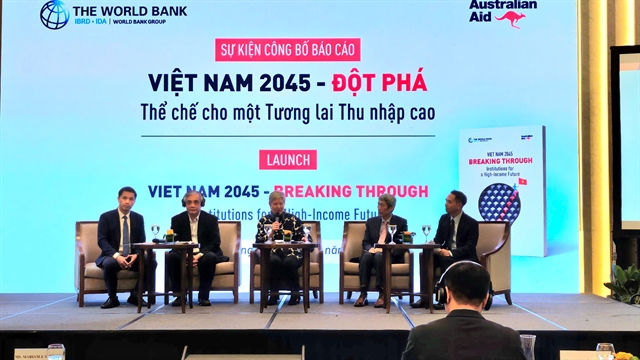 Economy
Economy

 |
| Delegates participate in the discussion panel at the World Bank event on Thursday morning. — VNS Photo Ly Ly Cao |
Ly Ly Cao
HÀ NỘI — Việt Nam’s aspiration to become a high-income country by 2045 hinges on bold institutional reforms that empower its private sector to take the lead in driving economic growth and job creation, said experts.
Speaking at the launch of two new reports released by the World Bank on Thursday morning, Mariam Sherman, country director for Việt Nam, Cambodia and Lao PDR at the World Bank, said that the country’s ambition to become a high-income country has brought renewed focus on institutions as enablers of sustained growth.
"Recent efforts show commitment, but achieving this goal will require even bolder reforms – an institutional 'big push' – to unlock the private sector’s potential to drive growth and create quality jobs for its people."
The first report, 'Việt Nam 2045: Breaking Through – Institutions for a High-Income Future', highlights the need to strengthen the legal and regulatory environment and streamline public investment to sustain the rapid growth required to meet this target.
It notes that countries that have escaped the middle-income trap and reached high-income status have done so by continuously improving the quality of their institutions.
The report calls for major improvements in public investment management, legal and regulatory predictability and sub-national governance.
Several reforms are critical for Việt Nam’s next phase of development, according to the report.
Public investment management needs to be more effective with improved project selection, implementation and oversight. In addition, strengthening the legal and regulatory framework will create a more predictable and transparent business environment.
Sub-national governance would be enhanced with more autonomy, accountability and better coordination across provinces. A high-income Việt Nam will also need an efficient and accountable civil service – one that is the right size, with better paid staff and backed by stronger institutions for due process, transparency and external oversight.
Economist Trần Đình Thiên, a member of the Prime Minister’s Advisory Council, stressed that the fate of Việt Nam’s high-income ambition is directly tied to the private sector’s trajectory.
"The future of Việt Nam’s high-income economy is essentially the future of its private sector," he said.
"If this sector doesn’t experience significant breakthroughs, particularly in competitiveness, the high-income dream will remain distant."
Thiên praised the recent political shift that officially recognised the private sector as the most important growth engine of the economy, calling it a necessary ideological breakthrough.
However, he warned that declarations alone are not enough.
"The key is not just calling it important – the crux lies in creating a truly free and enabling business environment where all players are guaranteed the right to reform and grow," Thiên said.
Additionally, Việt Nam’s transition to a high-income economy will require not only more private sector dynamism but also large-scale job creation in new industries, he added.
However, some Vietnamese experts have voiced concerns over the pace and top-down nature of current institutional reforms.
Nguyễn Quốc Trường, vice president of the National Institute for Economic - Financial Strategy and Policy under the Ministry of Finance, warned: "The greatest risk is that we’re building institutions and legal frameworks too rapidly and from the top down, without sufficient detection of problems. This could create uncertainties, especially as we restructure local governments, potentially stripping them of their economic centrality."
Green growth as a strategic imperative
The second report, 'Việt Nam 2045: Growing Greener – Pathways to a Resilient and Sustainable Future', provides a sobering assessment of Việt Nam’s climate vulnerability and the economic risks of inaction.
Without adaptive measures, climate impacts could reduce the country’s economic output by as much as 12.5 per cent by 2050. Already, about three-quarters of manufacturers in key export sectors like apparel and electronics operate in zones facing significant heat stress, putting over 1.3 million workers at risk.
"The good news is that there are actions that can be taken today to protect land, communities and infrastructure from climate shocks," Sherman noted.
"What matters now is putting in place the right mechanisms and incentives to encourage more adaptation by firms and households."
Strategic investments in climate adaptation, if well executed, could cut the projected GDP loss nearly in half, from 12.5 per cent to 6.7 per cent by mid-century.
The report advocates for embedding climate risk management into all areas of economic planning and infrastructure development. It also points to vast opportunities in green energy and marine resource management. – BIZHUB/VNS




